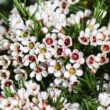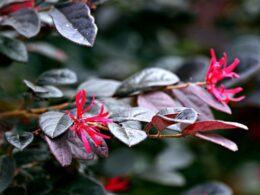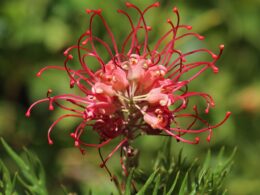The wolfsbane flower is a beautiful and deadly plant. Most of its many species are extremely poisonous, but some have been developed into gardener-friendly hybrids. Find out all about this curious flower!
What Is a Wolfsbane Flower? Names, Characteristics and Properties
Wolfsbane flowers are thought to get their name from their historical use for wolf hunting – they were probably used by Greeks and Romans to poison baits or arrows. They’re also known as monkshood, because the shape of the flowers resembles a monk’s hood. Other names for the plant include:
- aconite – from its genus Aconitum, which includes species like Aconitum napellus or Aconitum lycoctonum;
- leopard’s bane – suggesting its use in leopard hunting;
- mousebane – it may have been used to kill pests;
- women’s bane – possibly from its use as a method of murder;
- devil’s helmet – similarly to ‘monkshood;’
- queen of poisons – because of its general properties;
- blue rocket – due to its color and shape.
The plant is poisonous to humans, and the highest concentrations of its toxins are found in their roots and tubers. However, small doses of certain species are used in Ayurveda and traditional Chinese medicine.
Today, wolfsbane is mostly grown for its ornamental value. It produces tall spikes of purple or white flowers, and it blooms in the summer. Decorative hybrid varieties have been developed, and some have gained the Royal Horticultural Society’s Award of Garden Merit in the UK.
What Are the Ornamental Varieties of Wolfsbane Flowers?
Wolfsbane flowers are most commonly seen in shades of purple, but they can also be found in white, pink, and blue. Here’s a list of award-winning cultivars beloved by florists and gardeners:
- A. × cammarum ‘Bicolor’ – purple-and-white flowers;
- A. carmichaelii ‘Arendsii’ – azure blue flowers;
- A. carmichaelii ‘Kelmscott’ – blue flowers;
- A. ‘Bressingham Spire’ – violet-blue flowers;
- A. ‘Spark’s Variety’ – dark violet flowers;
- A. ‘Stainless Steel’ – silver-blue flowers.
All of them are easy to grow and make great cut flowers. However, they need to be handled carefully, as even the sap from broken leaves can cause skin irritation. They should also be kept away from children and pets.
How to Grow and Care for Wolfsbane Flowers?
Wolfsbane is a hardy plant that will grow in most soil types, as long as it’s moist and well-draining. It prefers full sun but will tolerate partial shade. The plant is fast-growing and short-lived, so it’s best to sow new seeds every year.
However, it’s technically a perennial, so it may come back in subsequent years. Once the plant has finished flowering, deadhead the spent blooms to encourage new growth. In winter, cut the plants back to the ground and cover them with a layer of mulch.
Where Can You Buy Wolfsbane Flowers and Seeds?
If you’re interested in growing wolfsbane flowers, you can buy seeds or plants from most large garden centers. You can also find them online from specialist nurseries. However, they’re not always easy to find, as many retailers don’t stock them due to their poisonous nature.
Symptoms of Wolfsbane Poisoning in People and Pets
All parts of the plant are poisonous, and ingesting even a small amount can be life-threatening. Symptoms of wolfsbane poisoning include:
- nausea;
- vomiting;
- diarrhea;
- abdominal pain;
- dizziness;
- weakness;
- seizures;
- irregular heartbeat.
In severe cases, wolfsbane poisoning can lead to coma and death. Pets are especially susceptible to the effects of wolfsbane, and even small amounts can be deadly. If you suspect that your pet has ingested wolfsbane, seek emergency veterinary care immediately.
Interesting Facts about Wolfsbane Flowers
Looking at wolfsbane, it’s hard to believe that this beautiful plant is so deadly. However, its toxicity has led to some interesting facts.
- Is has been hypothesized that Socrates was executed with a wolfsbane extract, as opposed to the hemlock. However, the hemlock hypothesis remains the most widely accepted.
- Pope Clement VII is said to have conducted a human trial of an antidote to wolfsbane in 1524. Two prisoners were intentionally poisoned with the plant, and the one who was given the antidote survived.
- In April 2021, the President of Kyrgyzstan promoted the use of aconite root to treat COVID-19. As a result, four poisoned were admitted to hospital.
Interested in Growing Wolfsbane?
To sum it up, wolfsbane flowers are beautiful but deadly. They’re easy to grow and care for, but need to be handled with caution. Have you ever grown wolfsbane? Let us know in the comments below.



















